Tree surgeon, arborist or chain saw man? Why you need to know…
I didn’t know the difference between a tree surgeon, an arborist (also known as an arboriculturalist) and a Chain Saw Man when we first moved into a garden with trees.
First, we got the trees cut by a man with a chain saw who told us he knew all about trees. He clearly didn’t, and chopped the branches off half-way along their length.
By the following summer, they’d sprouted in an ugly pattern around where he’d cut. The tree started to look like a lump of branches and foliage rather than a beautiful tree.
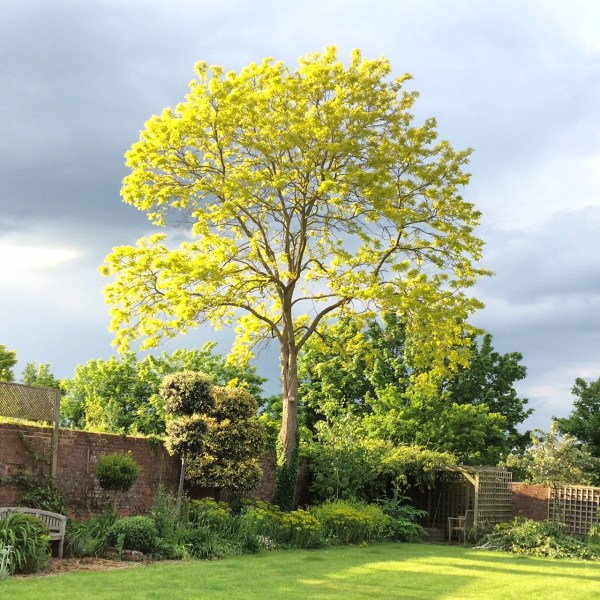
My favourite picture of our Robinia frisia. It’s only ever been lightly pruned to remove dead branches. I think it is a beautiful ‘tree shape.’
Qualified tree surgeons…
Then we started using qualified tree surgeons. The results were better, but variable. I hadn’t heard the word ‘arborist’ or ‘aboriculturalist’ at this stage. So, believing a tree surgeon to be a tree expert, I asked for advice on what trees to plant.
That was a mistake. I asked for a fast-growing evergreen recommendation to block an ugly street lamp and he supplied a Liquidambar and a rowan. They’re beautiful trees but they’re not evergreen. Or fast-growing. That’s not surprising, as I don’t think either are in the right position (see the Liquidambar below).
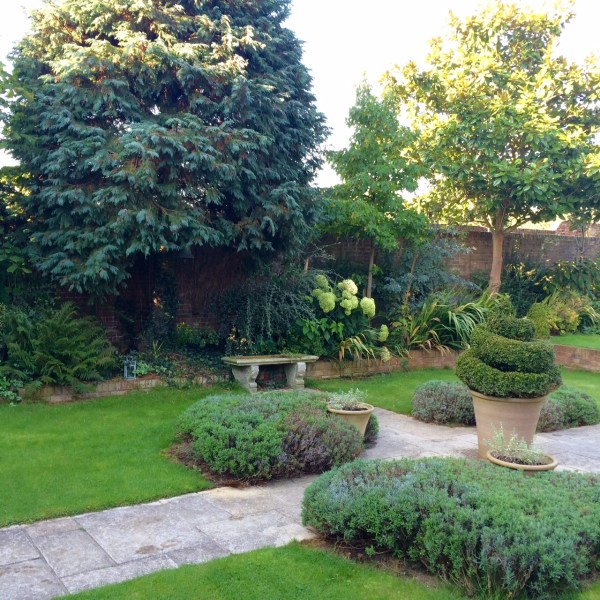
The Liquidambar is squashed between the conifer and the magnolia on the advice of a tree surgeon. We wanted a tree that could ultimately replace the conifer in blocking out a street lamp, but that’s not going to happen.
I’ve since puzzled over what the tree surgeon thought I wanted. ‘Evergreen’ and ‘deciduous’ don’t even sound like each other, so surely he didn’t mis-hear? They are wonderful trees for autumn colour, but that wasn’t my primary reason for needing a tree in that spot.
Of course, you might say (with justification) that I should have done my own research. But I thought he was an expert and that I knew nothing.
The first lesson of gardening
This brings me to the first lesson of happy gardening: even if you know nothing about gardening, you often do know what you want in your own garden. You may not know the right words or terminology, but you may have a surprisingly clear idea.
So if ‘experts’ don’t seem to make sense, question them. They may not have understood what you’ve asked for.
And don’t be afraid of asking ‘silly questions.’ We all know different things. You’re entitled to ask when you don’t know something.
Of course, what I really needed was an arborist/arboriculturalist or advice from a tree nursery. I like both trees, but I don’t think they’re in the best place for either their growing conditions or for what I wanted them for.
I’ve since researched and written a post on how to choose the perfect tree for your garden with all the advice I wish I’d known then.
So what’s the difference between a tree surgeon and an arborist?
I asked Matt Jackson of Land & Heritage to explain. Matt is a garden consultant, qualified arborist and advises on both domestic gardens and large estates. ‘Arboriculture goes beyond knowing how to prune trees and cut them down. An arborist or arboriculturalist is trained to understand the mechanics and biology of a tree, and everything that’s going on within it. He or she will be able to give you a detailed assessment of its health, vitality and safety. Whereas a tree surgeon’s job is prune or cut down trees.’
Some (less polite) arborists say that tree surgeons prune branches off trees but don’t know why they’re doing it or what effect it’ll have on the tree.
However, many tree surgeons do also have arboricultural qualifications. There are tree surgeons as well as arborists on the Arboricultural Association’s website.
‘Tree surgeons haven’t always been trained in tree diseases,’ adds Matt. ‘You need an arborist rather than a tree surgeon if you want advice on the health of your trees.’
Common tree health symptoms
Matt says that, as a homeowner, you’re in the best position to observe whether your tree is healthy or not. ‘Look at how your tree performs during the year,’ he advises. ‘Is the crown (the leaf canopy) thinning? Is it dropping its leaves earlier than usual? Are there whole section which are dead?
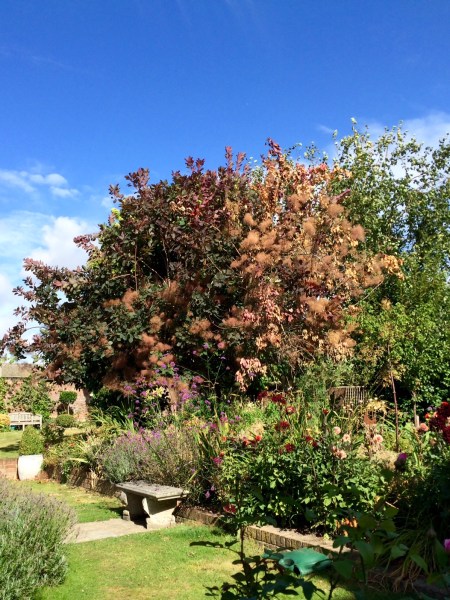
Our Cotinus suddenly died on the right hand side in 2016.
In autumn, fungus fruiting is a sign that something’s wrong with the tree. Holes, splits, cracks and oozing at any time of year are also all warning signs.
Matt also thinks that it’s worth doing a certain amount of self-diagnosis. ‘There’s so much help online – for example, on the RHS website. If you know what the tree is, look up the symptoms and you’ll get a pretty good idea of what’s wrong with your tree. You can find photographs, diagrams and videos.’
When our Cotinus coggyria ‘Grace’ suddenly died on one side, I consulted the internet, and then an arborist. Together we decided it was verticilium wilt, and that we would first try to keep the tree by cutting away the dead areas.
An arborist will discuss the issues
You have a legal responsibility to keep your trees safe.
However, that doesn’t necessarily mean cutting a tree down at the first sign of a problem. Chain Saw Man will suck his back teeth and tell you that tree must come down. A tree surgeon is also likely to advocate pruning or felling it. Only an arborist will give you a balanced view, according to what’s best for the tree and what you want for your garden.
You will have to pay a fee for that advice. But if there’s less tree surgery and felling as a result, you may save money by doing so.
For example, our Cotinus is a major feature in the garden. I really didn’t want to lose it. The official online advice on dealing with verticilium wilt is to slash and burn. Get rid of everything.
But the reality is that once you have something like honey fungus or verticilium wilt in your garden, it’s there for keeps. You manage it by not planting susceptible species.
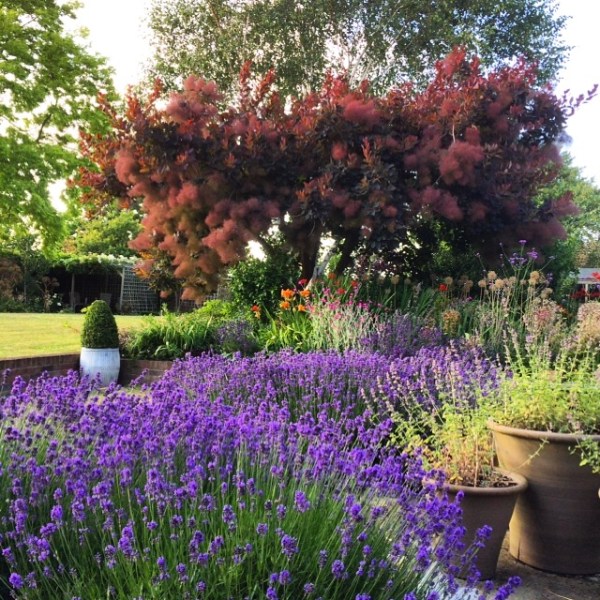
Losing the Cotinus (the red-leaved smoke bush) would have made a huge difference to the garden. Seen here in 2015 before it got verticilium wilt.
So we decided to cut away the dead parts and also to thin the rest so that there would be better air circulation. When it was pruned, I could see from the marks in the cut branches (by going on the internet!) that the tree had had bouts of verticilium wilt before. And in the autumn I added a layer of mulch to the soil.
Success…
Last summer there was no sign of the verticilium wilt. This winter we’ve had the Cotinus pruned back to about one third of what it was at its maximum size.
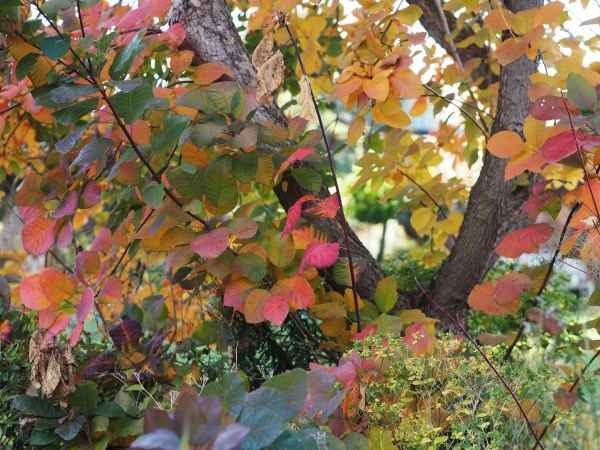
I’m updating this post three years after our original experience with the verticilium wilt. We are keeping the cotinus much smaller than it used to be, but it still looks healthy. So I’m glad I didn’t cut it down and burn it.

You can see the cotinus is looking healthy, but it’s quite significantly smaller than it was. We will continue to keep it small, as it seems healthier that way.
However, I did recently have an experience with ‘chain saw man’, which I thought was worth passing on. Someone knocked on our door and said he was ‘working on the trees next door.’
When I mentioned our neighbours’ names, he amended it to ‘no, next door to them.’ He then went onto say he’d noticed the trees in my front garden were rather overgrown, which they are. Did I want a quote, because he could ‘pull a couple of men off the other job and do my trees’?
When I questioned him about what he would do to the trees, he started to get aggressive. ‘Those trees are a nightmare, they’re just terrible.’ He suggested pruning the ornamental cherry (it should only be done in mid-summer and this was autumn). And he suggested pruning the viburnum, which is about to come into flower.
As I became increasingly uneasy, his tone grew more bullying. I took his card and said I would ask next-door-but-one if I could look at their trees after his work was done. He then amended it to ‘no, the house beyond that’ and went.
I should have known. Good tree surgeons and arborists very rarely have the spare capacity to knock on doors looking for work. You will often need to book them several weeks in advance.
Is my tree dead or is it just dormant?
And do a few dead branches mean the end of a tree? Matt showed me an easy test to tell whether a tree or branch is really dead. Use a knife to scrape away a small amount of the bark. If the tree is alive, you will see yellow or greenish growth under the bark. But if it is brown and dry, it is dead.
You can see this demonstrated here on a willow tree at Leeds Castle.
How much will an arborist cost?
I can’t find any official figures, but most qualified gardening experts cost around £35 to £50 an hour. Time spent writing up reports, making recommendations and travel should also be counted in. For more about finding the right gardening expert, see my posts on garden appraisals and finding the right gardener for your garden.
I’ve seen tree surgeons quote around £40 an hour or £200 a day per person. They often have to work in teams of two or more, and there’ll be added charges for the use of special equipment.
Fees depend on what part of the country you’re in, so get a few quotes before deciding. Although I’ve often found that if I ring half a dozen companies, only two reply and only one turns up, so comparing quotes isn’t always as easy as it sounds.
Find a professional via the Arboricultural Association.
Matt Jackson can be contacted at Land & Heritage.
Don’t try to cut costs…
Working with trees and power tools is genuinely dangerous, not just for the person up the tree with a chain saw, but also for anyone standing around.
A friend of mine once booked a tree surgeon who failed to turn up, so an unqualified man who’d done some odd jobs for her offered to prune the tree instead. He died falling out of it onto some railings. It really is that dangerous.
Would you need a tree surgeon or an arborist to shape your trees?
You can grow quite large trees even in the smallest spaces if you prune or shape them. However, this means trimming them yearly, so it’s important to find someone who can do this. A good tree surgeon should be able to do it. Or, if you’re keeping the shape quite restricted and low, a professional gardener can do it.
See this post for more about choosing shapes and styles of trees for small gardens.
More help for your garden trees
The key reason why trees is fail is that they’re planted badly. So find out how to plant a tree here.
See this post to find out how to choose trees for garden privacy. If you’d like to grow fruit trees in a small garden, see ‘An orchard in the garden – you do have the space!’
And if you have a tree in your garden which feels too big, think about pruning it before deciding to cut it down. See how to prune for both light and privacy for ‘transparent pruning’ techniques.
And for a comprehensive handbook on trees for small gardens, see Alan Titchmarsh’s How To Garden: Small Trees. It has recommendations for trees, plus care and pruning advice.
Note that links to Amazon are affiliate, see disclosure.
Pin to remember what an arborist does
And do join us for a free weekly email with tips, ideas and inspiration for your garden.
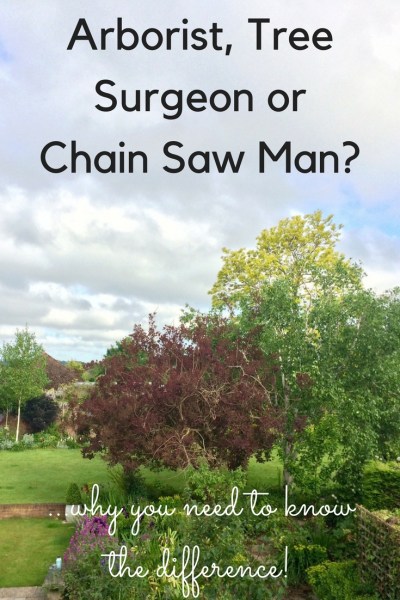
























I’m writing because I am considering hiring one of these professional tree services to look at our trees in order to help keep them healthy and trimmed. Who do you recommend? And what should we anticipate paying for this service?
Thanks so much!
I can’t recommend any particular professional tree service, because I don’t have personal experience of any except for the tree surgeon who cuts our trees. The Arboricultural Association has a Find a Member service: https://www.trees.org.uk/Find-a-professional. there’s a huge range in what tree surgeons cost, depending on the job – it will be cheaper and easier to have a few branches trimmed by one person than for chopping down a big old tree, which will usually have to be done by a team of 3. I have heard of several instances of people quoting £3,000 for removing a big old tree, and I have also heard that £120 an hour for a team of 3 is normal. However, these costs will vary according to where you live and how difficult the job is. T
There is certainly a difference between a tree surgeon and arborist, but I’ve never heard the phrase “Chainsaw man” .
Another person to mention is a tree surveyor. They can be considered as arborists as they have knowledge of tree condition and health.
You make an excellent point, thank you.
Hugely useful article – I have spent hours googling ‘tree surgeons’, tree pruning, techniques RE how and when, avoiding water-sprouts etc. I was told by a chain saw man (as I now realise he was!) you could do ‘anything’ to our beautiful purple leaved prunus and it would bounce back. I didn’t feel comfortable proceeding, and reading your post am pleased I didn’t. Now, to locate an arboriculturist. Thank you!
Thank you for letting me know, good luck with finding the right person.
I had a thought today whilst pruning 5 very misshapen fruit trees, the process of hand pruning (saw, lopper, ladder and long handled pruner) allows for a measured approach to pruning. The physical action of ‘hand pruning’ forces you to think about the structure and the reason the tree is growing in a certain way, with out sounding like a tree whisperer or a old hippy.. to tackle the task quietly, slowly and by hand really works for us.
That’s a good thought, makes alot of sense.
As a person who knows nothing about my only tree in my backyard your post means a lot. Now I realize the man who prunes my tree every year is a chain-saw man who is not really understanding my tree who seems to suffer, when I see the branches now that is completely bland and will soon start to sprout green. I will make my own research regarding my tree (a catalpa) and will be able to better know what it really needs and give a better prune at a proper time. Thank you from Spain!
Thank you! And I hope you find the right person – it may take a few years of proper pruning and growing to get the tree into a good shape, but it’s so worth it.
If you live in a conservation area a tree surgeon will sort out the relevant permissions too. From memory it’s trees with trunks above three inches diameter that require planning permission (and six weeks notice), but obviously check with the planning department.
A very timely reminder – thank you! I should have mentioned that, and you’re right – in the UK if your tree is in a Conservation Area and has a trunk diameter of more than 75mm when measured 1.5m from the ground, then you will need planning consent – or at least to give local authorities 6 weeks’ notice – to prune or fell it. If you’re thinning or removing a tree in order to give other trees around it more space, then it’s 100mm diameter. I’ve had a look at exemptions (for example, are Leylandii cypresses automatically protected?) but it’s not clear from Government websites which, if any, trees are automatically exempt. So if in doubt consult your local authority. It also seems – although once again, it’s not very clear – that trees that can be seen from the road or another public area are the ones that local council tree officers are most concerned with, along with the preservation of ‘woodland.’
A very large proportion of our fruit tree pruning work is rescuing trees blunt ‘pruned’ with a chain saw. Simply tackling the extremity of growth is not the whole story, the timing of pruning is vital. We suggest if you are getting someone in they should be professional enough to explain the rationelle behind what they do!
I know some of the trees you look after, David, and they look beautiful. And thank you for mentioning the timing – yes, essential!
Ooooh snap! We moved in to our house 18 months ago and we have a beautiful Cotinus Coggygria – we reckon about 10 years old . I absolutely love it so was devastated to discover what I think is Verticillium wilt on the right side (googled to reach this conclusion!). We thought the tree was doomed! We were going to give it til autumn to see what happened and then probably get rid!
Is it possible to prune back ourselves do you think? Is it even necessary if it’s likely to have had it before?
Love your emails by the way!
Thank you! We had all the dead wood removed, which meant a better circulation of air around the remaining branches and canopy. If you do this yourself (and Cotinus makes a very small tree, so it should be possible), then make sure you remove whole branches from where they meet the trunk. Don’t cut across the middle of branches or they will sprout. I think it’s worth a try – after all, ours has now recovered from two bouts of verticilium wilt. We also put a nourishing mulch around it. I don’t normally water any plant that is well established, but I did notice that our tree did its dramatic dying-on-one-side after a prolonged hot and dry spell in August, so it may be worth giving it at least one really good soaking if we have (ha ha) any prolonged hot dry spells this summer. If you need to replace it, the RHS has a good list of plants that are resistant to verticilium wilt:https://www.rhs.org.uk/advice/profile?PID=255. Hope it works – good luck!
Our road has many large well-established trees on it. Unfortunately they’re maintained by chain-saw men working for the local council. The sight of them leaving huge gaping wounds all over the cherry trees, often cut at the worst time of year for the bacterial canker infections that prunus are prone to, makes me really angry. Some I think are already sick and I’m convinced they’ll be the death of most of them eventually.
The problem is that chain-saw men are cheap and people aren’t willing to pay for expertise. It’s the same with ‘gardeners’: a really talented gardener won’t come to your house for the minimum wage.
I agree with you. It’s one of the reasons why I wrote this post, and also the other two on finding a gardener and getting a garden appraisal – to help people understand that paying for specialist help in the garden is really worthwhile and can make such a difference to the look and health of your garden.